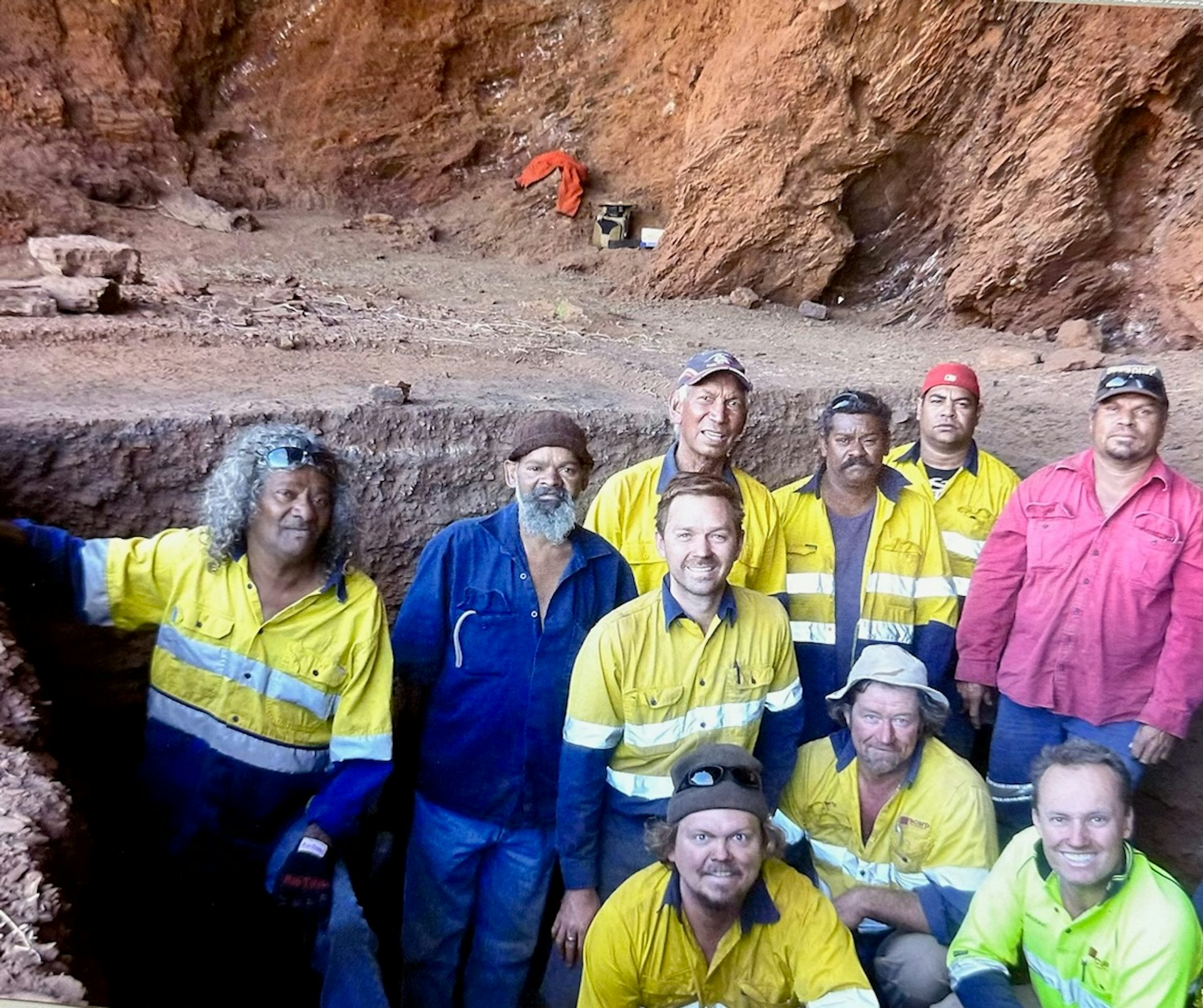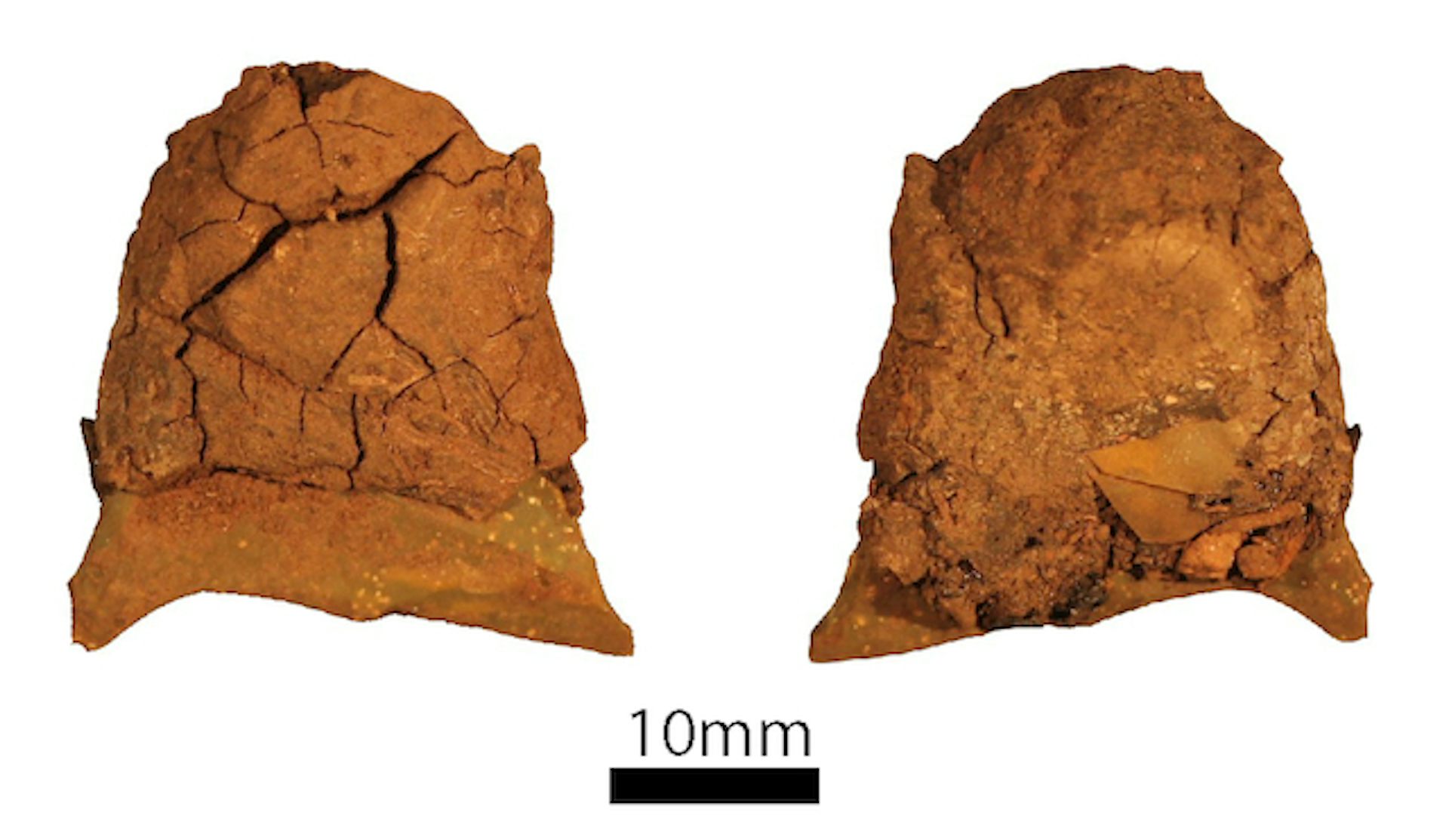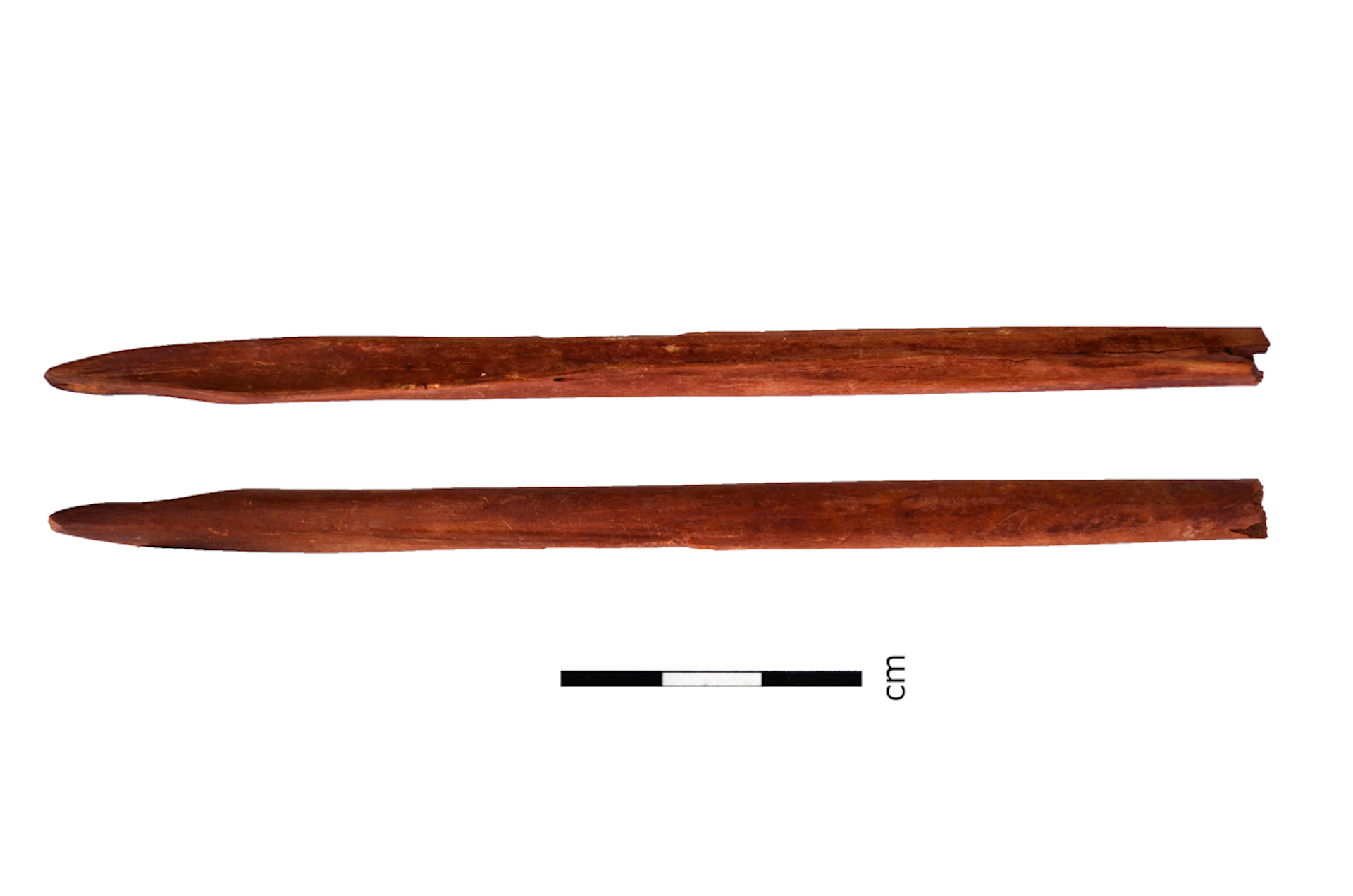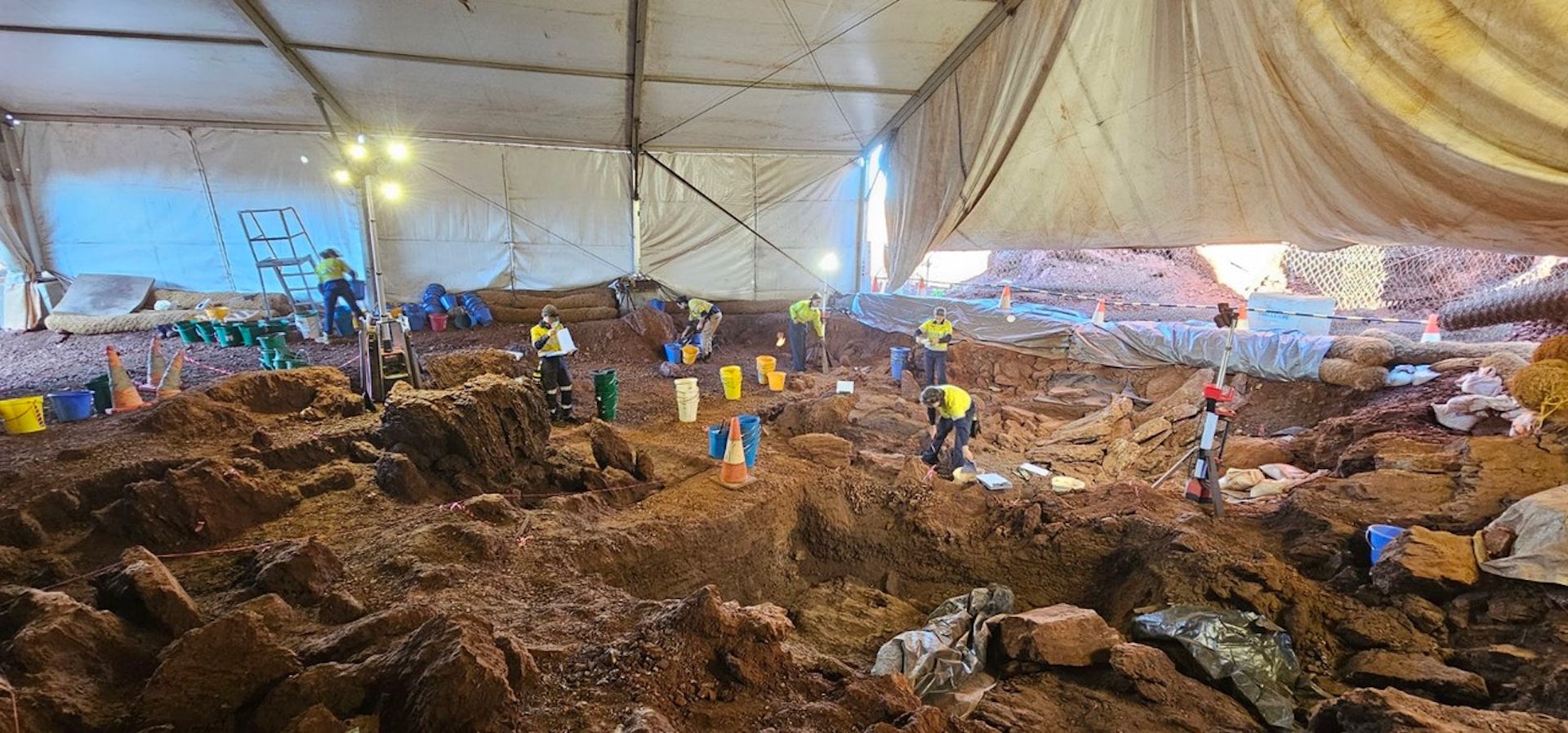The first published results from Juukan Gorge show 47,000 years of Aboriginal heritage was destroyed in mining blast
On of the first pieces of good news for the creation cult emerged from Australia a couple of days ago. It was that one of the best pieces of evidence of continuous human occupation with no signs of ever being submerged in a flood, has been destroyed by mining activities.
It was an ancient rock shelter at Juukan Gorge in Puutu Kunti Kurrama Country in the Pilbara region of Western Australia, which had evidence of human occupation going back 47,000 years, i.e. 37,000 years before Bible literalist creationists believe the Universe was magicked up out of nothing, and 43,000 before it was supposedly submerged in deep flood water that would have obliterated any trace of human habitation.
It was the kind of solid, incontrovertible evidence of biblical errancy that keeps creationist cult leaders awake at night trying to make up lies to tell about it or discredit it in some way that a creationist will believe (not hard; just say the scientists hate God and make up lies, that'll make a creationist feel special).
How the site came to be destroyed and the attempts to recover the artifacts it contained is the subject of an article in The Conversation by Michael Slack, Director, Scarp Archaeology and Adjunct Associate Professor of Archaeology, James Cook University; Jordan Ralph, Adjunct Lecturer, Archaeology, Flinders University and Wallace Boone Law, Postdoctoral Researcher, Geospatial Science and Archaeology, University of Adelaide. Their article is reprinted here under a Creative Commons license, reformatted for stylistic consistency:

The first published results from Juukan Gorge show 47,000 years of Aboriginal heritage was destroyed in mining blast
The excavation team at Juukan Gorge in 2014.
Courtesy of Scarp Archaeology and PKKP Aboriginal Corporation
Michael Slack, James Cook University; Jordan Ralph, Flinders University, and Wallace Boone Law, University of Adelaide
Aboriginal and Torres Strait Islander readers are advised this article contains an image of deceased people, which is used with permission from the Traditional Owners.
In May 2020, as part of a legally permitted expansion of an iron ore mine, Rio Tinto destroyed an ancient rockshelter at Juukan Gorge in Puutu Kunti Kurrama Country in the Pilbara region of Western Australia.
Working with the Traditional Owners, we had excavated the shelter – known as Juukan 2 – in 2014, six years before its destruction. We found evidence Aboriginal people first used Juukan 2 around 47,000 years ago, likely throughout the last ice age, through to just a few decades before the cave was destroyed.
The site held thousands of significant objects including an ancient plait of human hair, tools and other artefacts, and animal remains. The results of the excavation led to last-minute efforts to stop the destruction of the site, but they were unsuccessful.
The full results of the excavation are published for the first time today in Quaternary Science Reviews.

The excavation team at Juukan 2 in 2014. Back, L–R: J. Ashburton (deceased), C. Ashburton (deceased), T. Smirke (deceased), Harold Ashburton, R.J. Mckay, Terry Hayes. Middle, L–R: Jarrod Brindley, Martin Cooper (deceased). Front, L-R: W. Boone Law, Michael Slack.
Scarp Archaeology
Juukan is a gorge system with a series of caves in Puutu Kunti Kurrama Country, approximately 60 km north west of Tom Price, in the Pilbara region of Western Australia.
The Juukan 2 rockshelter is one of the caves that make up this system. It was once part of a deep gorge featuring fresh water holes, large camping areas surrounded by massive ironstone mountains and a large river that flowed at some times of the year and was dry at others.
Today the area is part of a Rio Tinto iron ore mine. As widely reported in May 2020, the Juukan 2 rockshelter was destroyed during mine expansion activities. While Rio Tinto held ministerial consent to destroy the heritage site, the action was against the wishes of the Traditional Owners.
The destruction led to widespread global condemnation and shone a spotlight on Western Australia’s substandard heritage protection legislation.
What is so significant about Juukan?
Juukan Gorge is named after a Puutu Kunti Kurrama ancestor. It is extremely significant both for cultural and scientific reasons.
For the Puutu Kunti Kurrama, Juukan is a deeply spiritual place that contains deep-time evidence of their presence and association with the landscape in their Traditional Country.
In terms of the scientific significance of Juukan 2, the site is one of the oldest known locations of Aboriginal settlement of Australia. While there are some sites that have been found to be older, such as Madjedbebe in Kakadu in the Northern Territory and off the Western Australian coast, there are only a few places as old as Juukan in inland Australia.
Juukan is about 500 kilometres from the coast today. Up until approximately 10,000 years ago, when sea levels rose, it was almost 1,000 kilometres inland.
This means people living around Juukan were adept at living in the desert. This is also shown by the fact they were able to continue to use the cave even during the last ice age (from around 28,000 to 18,000 years ago). Archaeologists have found very little direct evidence from this period at any other sites.
Often just a handful of artefacts is regarded as enough evidence to show people used an archaeological site. However, at Juukan 2 we found thousands of artefacts, including many that featured resin from spinifex grass, which was likely used as a kind of glue to hold together the pieces of composite tools.

A shaped piece of stone that would likely have been glued to a handle with spinifex resin, excavated in 2014.
Scarp Archaeology
Among this material was a plait of human hair dated to around 3,000 years old. The hair was DNA tested and the results told us it was likely related to the Traditional Owners who were part of the excavation team.
The material we found was extremely well preserved. We even found a bone point made from a kangaroo’s shinbone around 30,000 years old with ochre on its end. We don’t know what this was used for, but the ochre may indicate a ritual function.
What now?
After the blast in 2020, we began to re-excavate the site. Over the past two years we have removed about 150 cubic metres of rubble that was once the roof and back wall of the cave. Beneath the debris we found traces of organic material, and then remnants of the cave floor.
Excavations have now reached the original floor level throughout most of the site, and we are carefully digging and finding more incredible materials. This includes more plaited hair, shell beads we think were brought from the coast, and fragments from the jaw of a Tasmanian devil, an animal which has been extinct on mainland Australia for over 3,000 years.
The publication of these results from 2014 is just the next chapter in the archaeology of Juukan 2, a place special to the Traditional Owners, but also of immense significance to science and our understanding of cultural heritage of Australia.
The Puutu Kunti Kurrama and Pinikura Aboriginal Corporation is a co-author of this article and the associated research, recognised collectively according to their cultural preference.
Michael Slack, Director, Scarp Archaeology and Adjunct Associate Professor of Archaeology, James Cook University; Jordan Ralph, Adjunct Lecturer, Archaeology, Flinders University, and Wallace Boone Law, Postdoctoral Researcher, Geospatial Science and Archaeology, University of Adelaide
This article is republished from The Conversation under a Creative Commons license. Read the original article.
What can you tell me about the Juukan Gorge in Puutu Kunti Kurrama Country in the Pilbara region of Western Australia? Juukan Gorge is a significant archaeological and cultural site located in Puutu Kunti Kurrama and Pinikura (PKKP) country within the Pilbara region of Western Australia. This area is of immense importance due to its rich Indigenous heritage and archaeological findings, which provide insights into the long history of human habitation in Australia.More technical, archaeological information is provided in the open access paper in Quaternary Science Reviews
Key Points about Juukan GorgeConclusion
- Cultural Significance:
- Juukan Gorge holds profound cultural and spiritual importance for the PKKP people, who have inhabited the region for tens of thousands of years.
- The site includes rock shelters, petroglyphs, and other cultural artifacts that are central to the identity and heritage of the PKKP people.
- Archaeological Findings:
- Excavations at Juukan Gorge have uncovered evidence of continuous human occupation dating back over 46,000 years.
- Artifacts found at the site include tools, grinding stones, and a plait of human hair, which provided the oldest known direct link to contemporary Aboriginal Australians through DNA analysis.
- Destruction in 2020:
- In May 2020, Rio Tinto, a global mining corporation, legally destroyed parts of Juukan Gorge as part of an expansion of their iron ore mining operations.
- The destruction of the rock shelters sparked national and international outrage due to the site's cultural and archaeological significance.
- This event led to widespread criticism of the legal frameworks governing heritage protection in Australia and prompted calls for stronger safeguards for Indigenous sites.
- Legal and Social Implications:
- The destruction led to a parliamentary inquiry in Australia, which examined the adequacy of the Aboriginal Heritage Act 1972 (WA) and other protective measures.
- The inquiry's findings and subsequent reports highlighted the need for reform in heritage protection laws and greater involvement of Indigenous communities in decision-making processes regarding their cultural sites.
- Response and Reforms:
- Following the incident, Rio Tinto faced significant backlash, including from investors, leading to the resignation of several senior executives.
- Efforts are ongoing to strengthen heritage protection laws, with increased emphasis on recognizing and respecting Indigenous cultural heritage and ensuring that similar events do not occur in the future.
Juukan Gorge serves as a poignant reminder of the need to balance development with the preservation of cultural heritage. The incident has catalyzed a broader movement towards recognizing and protecting Indigenous cultural sites in Australia, emphasizing the importance of Indigenous voices in heritage management and policy-making.
The bad news for creationists is that, although the site has been destroyed by Rio Tinto, the record of its existence still exists as do the artifacts recovered from the site. Their only recourse, therefore, is to find some way to dismiss the fact that there were people living in Australia at least 37,000 years before 'Creation Week' and that these first Australians lived there continuously though the legendary flood which left not a single trace on sites such as Juukan Gorge in Puutu Kunti Kurrama Country, Western Australia.Highlights
- Our submission is novel and innovative in that it provides the first in depth scientific analysis of the world significant Juukan 2 rockshelter site. It provides a revision and update of the original 2008 test excavation results, alters the regional archaeology of the inland Pilbara, and Australia based on new methods and excavation data. The results substantially revise the known antiquity of human occupation for the region and with that our understanding of the timing and processes of human settlement of the arid interior of Australia.
Abstract
Archaeological and palaeoenvironmental investigations at Juukan 2 rockshelter have yielded new information on the ancient Aboriginal occupation of the Pilbara uplands in northwest Australia. Using multiple lines of evidence, including lithic, faunal, pollen, ancient DNA, radiocarbon dating, optically stimulated luminescence, and Bayesian chronological modelling, we show that Aboriginal people occupied the western Hamersley Plateau as early as 47,000 years ago (47 ka). Late Pleistocene populations utilised a diverse range of tool technologies, including bone points, grindstones, and flaked stone artefacts. Palaeoclimatic conditions at Juukan 2 rockshelter varied greatly over the past 47 ka, with repeated site visits by people, including during the peak hyper-arid phase of the Last Glacial Maximum (LGM) c. 21 ± 2 ka. Ancient starch analyses of the ground stone artefacts show the processing of Ipomoea (Bush Potato) from around 42 ka to the present day. Pronounced increases in the discard of stone artefacts and bone in the last 3500 years are interpreted to be the result of increased frequency of site use. A braided hair fragment dated to this period has demonstrated genetic links between the earlier rockshelter occupants and contemporary Puutu Kunti Kurrama and Pinikura peoples, who have maintained strong cultural connections to the area.
1. Introduction
The Pilbara region of Western Australia contains an extensive record of Late Pleistocene Aboriginal settlement extending from the coast to the uplands of the Hamersley Plateau (Bird and Rhoads, 2015; Hughes et al., 2011; Law et al., 2010; Cropper and Law, 2018; Marsh et al., 2018.1; Marwick, ; Morse et al., 2014; Reynen, 2019; Reynen et al., 2018.2; Slack et al., 2009, 2017, 2018.3, 2020) (Fig. 1). Along the Pilbara coast, evidence for a human presence has been detected from approximately 51,000 years ago at Boodie Cave on Barrow Island, and from 40,000 years ago at Cape Range (Ditchfield, 2017.1a; Morse, 1993; Veth et al., 2017.2a, 2017.3b). Up to 500 km further inland, the rockshelter sites of Yurlu Kankala and Kariyarra (Cropper and Law, 2018; Marsh et al., 2018.1; Morse et al., 2014; Reynen et al., 2018.2; Slack et al., 2018.3, 2020) and Watura Jurnti (Marsh et al., 2018.1) date to 45,000 years ago, while investigations at Karnatukul (Serpents Glen) (McDonald et al., 2018.4) on the edge of the Little Sandy Desert report a modelled age of 50,010 cal BP - 45,190 cal BP, which is consistent with other sites across the region, such as Parnkupirti on the edge of Lake Gregory, Great Sandy Desert (Veth et al., 2009.1). There is increasing evidence to support the proposition that initial human settlement of the Australian interior, including the arid rangelands, occurred rapidly and commenced well before 45,000 years ago.
 Fig. 1. Map of the Pilbara region and Hamersley Plateau showing key regional Pre-LGM archaeological sequences: 1. Juukan 1 & 2; 2. Newman Rockshelter; 3. Newman Orebody XXIX; 4. PAD10-17; 5. Djadjiling; 6. Jundaru (Malea); 7. HS-A1; 8. HD07-3A-PAD13; 9. Milly's Cave; 10. Mesa J-24; 11. Kariyarra Rockshelter; 12. Yurlu Kankala Cave; 13. Boodie Cave; 14. Watura Jurnti.
Fig. 1. Map of the Pilbara region and Hamersley Plateau showing key regional Pre-LGM archaeological sequences: 1. Juukan 1 & 2; 2. Newman Rockshelter; 3. Newman Orebody XXIX; 4. PAD10-17; 5. Djadjiling; 6. Jundaru (Malea); 7. HS-A1; 8. HD07-3A-PAD13; 9. Milly's Cave; 10. Mesa J-24; 11. Kariyarra Rockshelter; 12. Yurlu Kankala Cave; 13. Boodie Cave; 14. Watura Jurnti.
The timing of settlement on the Hamersley Plateau has long been discussed in the archaeological literature, with suggestions that the montane biogeography of this region may have been a ‘refuge’ for people during periods of extreme aridity during the Last Glacial Maximum (LGM), c. 21 ± 2 ka (e.g., Williams et al., 2009.2). The argument has been that occupation at this time was concentrated on the eastern part of the plateau. The oldest published archaeological sites for the Hamersley Range: Newman Rockshelter (including PAD10-17), and Newman Orebody XXIX (Slack et al., 2018.3, 2020), and Djadjiling, Jundaru, HS-A1 and HD07-3A-PAD13 (Cropper and Law, 2018; Law et al., 2010; Slack et al., 2018.3) (see Fig. 1), cluster near the eastern plateau margins, with sequences dated to between 45,000 and 40,000 years ago. These investigations, therefore, have established human occupation of the region >40,000 years, but thus far no archaeological sites of similar antiquity have been reported for the western plateau.
For the western Hamersley Plateau, three archaeological sites contain cultural materials >30,000 years in age: Mesa J24, Juukan 1, and Juukan 2 ( Slack et al., 2009; Hughes et al., 2011, Fig. 1). The presence of artefacts below the oldest radiocarbon determination of 29,301 - 27,657 cal BP (WK-2514) at Mesa J24 led Hughes et al. (2011) to argue for an initial human presence prior to 29,000 years ago. Like other archaeological sites of this age or older (e.g., Devils Lair, Turney et al., 2001), the lowest stratigraphic levels of the sequence yielded very few artefacts, in this case fewer than ten. Previous excavations at Juukan 1 and Juukan 2 suggested an older and better-preserved archaeological record than that identified at Mesa J 24, although further work was required to better understand the temporal limits of the Late Pleistocene archaeological sequence at these sites (Slack et al., 2009).
This paper presents the results of the 2014 investigations at Juukan 2 rockshelter, combining the archaeological and palaeoenvironmental analyses with the results of the previously published 2008 study (Slack et al., 2009). A new and revised chronology for a human presence on the western Hamersley Plateau is reported and situated in the context of other studies for the region; implications of the findings for our understanding of the timing and process of the peopling of Sahul are discussed.
Slack, Michael J.; Law, W. Boone; Coster, Adelle C.F.; Ditchfield, Kane; Field, Judith; Garvey, Jillian; Gliganic, Luke A.; Moss, Patrick; Paul, Jarrad W.; Reynen, Wendy; Ward, Ingrid; Wasef, Sally; Puutu Kunti Kurrama and Pinikura Aboriginal Corporation
A 47,000 year archaeological and palaeoenvironmental record from Juukan 2 rockshelter on the western Hamersley Plateau of the Pilbara region, Western Australia
Quaternary Science Reviews (2024) 338 108823, https://doi.org/10.1016/j.quascirev.2024.108823
Copyright: © 2024 The authors.
Published by Elsevier B.V. Open access.
Reprinted under a Creative Commons Attribution 4.0 International license (CC BY 4.0)
But then how could people who thought the Universe was a small flat planet with a dome over it have had the slightest inkling that Earth was a spheroid and there were people living in the southern hemisphere who had lived there for several tens of thousands of years? The idea would have seemed as preposterous to them as the idea that Earth orbits the sun in just one of maybe half a trillion galaxies each with maybe half a trillions such suns, in a Universe that was already nearly 13.8 billion years old when they were filling the gaps in their understanding with simplistic tales of magic and mystery, mostly borrowed from nearby cultures and other feuding tribal despotisms.
Unfortunately for creationists, the evidence of how scientifically and historically ignorant the Bible's authors were is not confined to one site in Australia but is revealed throughout the entire body of science.
It takes a special form of delusion or retarded intellectual development to think that their mummy's and daddy's beliefs trump scientific evidence, or that all the world's scientists, archaeologist, palaeontologists and anthropologists are part of a massive conspiracy to prove their mummy and daddy wrong.
What Makes You So Special? From The Big Bang To You
How did you come to be here, now? This books takes you from the Big Bang to the evolution of modern humans and the history of human cultures, showing that science is an adventure of discovery and a source of limitless wonder, giving us richer and more rewarding appreciation of the phenomenal privilege of merely being alive and able to begin to understand it all.
Available in Hardcover, Paperback or ebook for Kindle
Ten Reasons To Lose Faith: And Why You Are Better Off Without It
This book explains why faith is a fallacy and serves no useful purpose other than providing an excuse for pretending to know things that are unknown. It also explains how losing faith liberates former sufferers from fear, delusion and the control of others, freeing them to see the world in a different light, to recognise the injustices that religions cause and to accept people for who they are, not which group they happened to be born in. A society based on atheist, Humanist principles would be a less divided, more inclusive, more peaceful society and one more appreciative of the one opportunity that life gives us to enjoy and wonder at the world we live in.
Available in Hardcover, Paperback or ebook for Kindle








No comments :
Post a Comment
Obscene, threatening or obnoxious messages, preaching, abuse and spam will be removed, as will anything by known Internet trolls and stalkers, by known sock-puppet accounts and anything not connected with the post,
A claim made without evidence can be dismissed without evidence. Remember: your opinion is not an established fact unless corroborated.